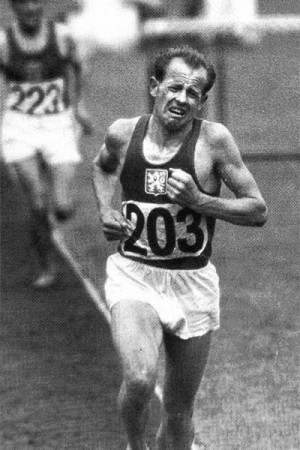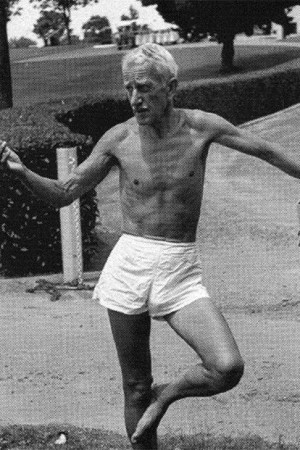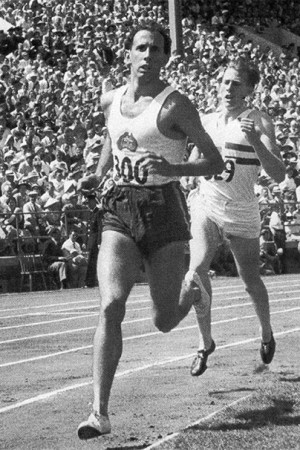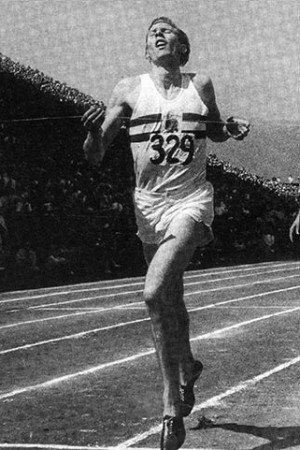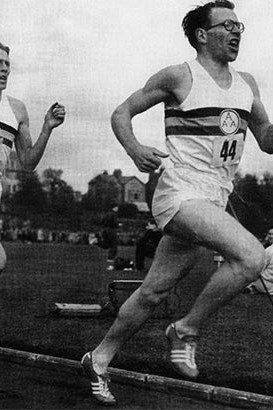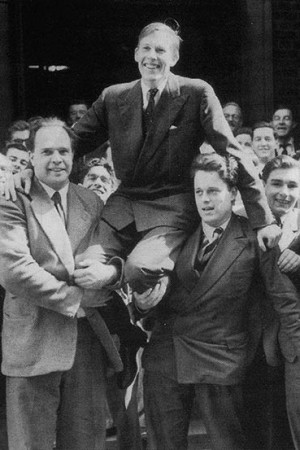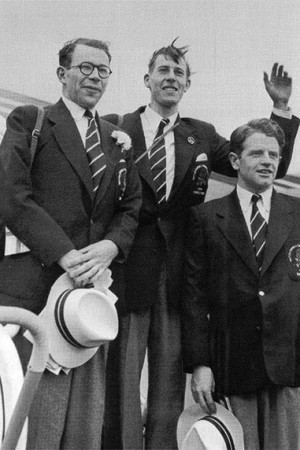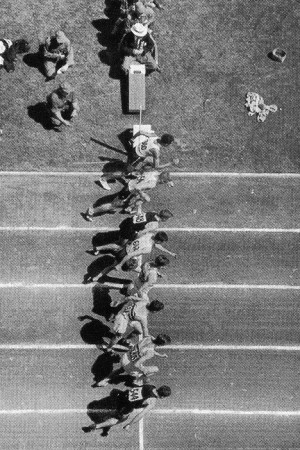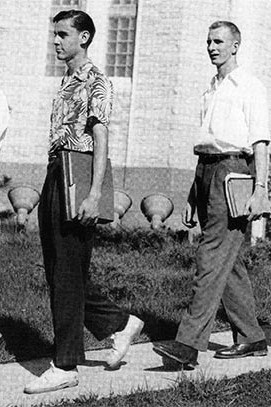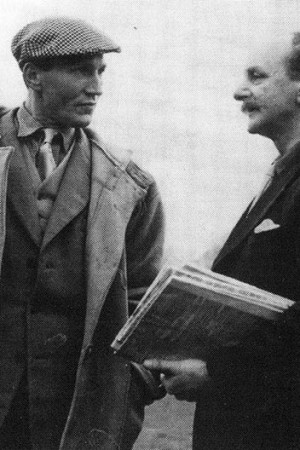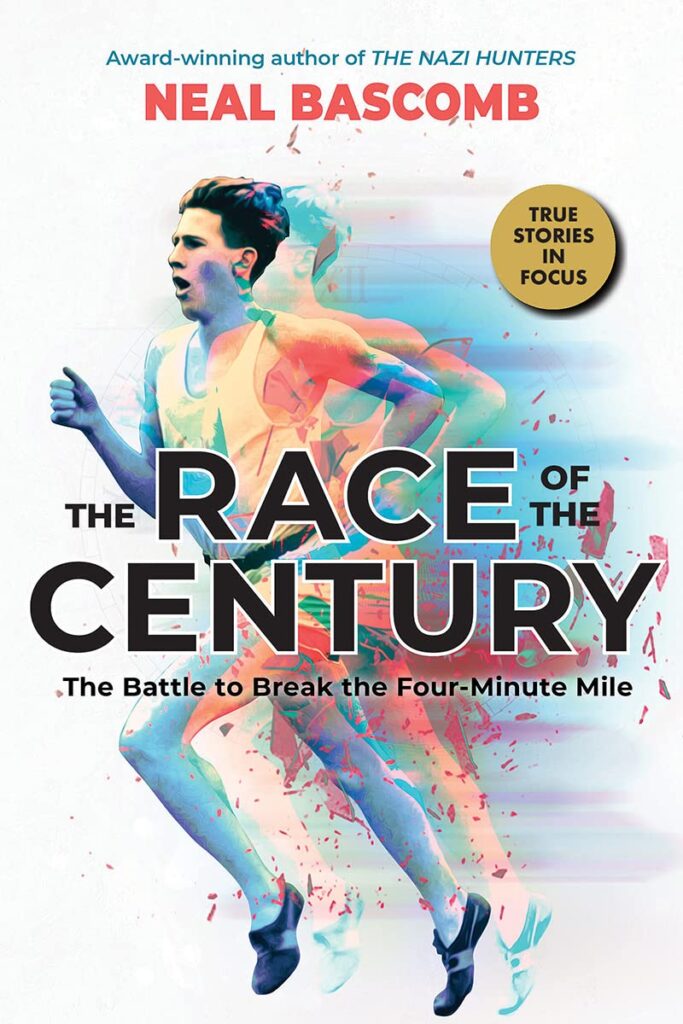
The Race of the Century: The Battle to Break the Four-Minute Mile
Highly acclaimed author Neal Bascomb brings his peerless research and fast-paced narrative style to a young adult adaptation of one of his most successful adult books of all time, The Perfect Mile, an inspiring and moving story of three men racing to achieve the impossible — the perfect four-minute mile.
There was a time when running the mile in four minutes was believed to be beyond the limits of human foot speed. In 1952, after suffering defeat at the Helsinki Olympics, three world-class runners each set out to break this barrier: Roger Bannister was a young English medical student who epitomized the ideal of the amateur; John Landy the privileged son of a genteel Australian family; and Wes Santee the swaggering American, a Kansas farm boy and natural athlete.
Spanning three continents and defying the odds, these athletes’ collective quest captivated the world. Neal Bascomb’s bestselling adult account adapted for young readers delivers a breathtaking story of unlikely heroes and leaves us with a lasting portrait of the twilight years of the golden age of sport.
Reviews
“Superb.” —Newsweek
“Stylish and absorbing.” —Los Angeles Times
“A rare literary win. In finding the right balance of humanity and a sense of immediacy, Bascomb has penned a sports tribute book that transcends the genre.”
—Oregonian
“Captivating … Each attempt at the sub-four is more emotional than the last … Every 4:02—or, worse, 4:00.6—wounds … Much joy and inspiration to be found here.”
—Entertainment Weekly
“Well-paced and diligently researched.”
—The Economist (London)
“Absorbing … Bascomb invests the events and the characters involved with just the right measure of restraint and poetry.”
—The Age (Australia)
“Written at a pace sure to break the four-minute mile … Delightful in its detail, inspirational in its message.”
—Seattle Times
“A vivid human-interest story … Engrossing, excruciating and exhilarating.”
—Boston Herald
“A fine, gripping book.” —Chicago Sun Times
“A great story, breathlessly told, at once homely and ambitious.”
—The Times (London)
“In masterly fashion, Bascomb recreates the battle of the milers, embellishing his account with fascinating forays into runner’s lore. It’s a mark of his skill that, although the race’s outcome is well known, he keeps us in suspense, rendering in graphic detail the runners’ agony down the final stretch.”
—The New Yorker
“Compelling human drama. A resplendent story of an epic event in sports history.”
—Christian Science Monitor
“Enthralling. The Perfect Mile returns the reader to a time when a sporting ideal was not an oxymoron.”
—NYT Book Review
“Brilliant…The must read sports book of the year.”
—Boston Globe
“A 50-year-old racing story of shimmering hope and impossible odds…Quaint in the way great myths are quaint: simply structured, resonant with implication, ageless, universal.”
—San Francisco Chronicle
“Stylistic flair, psychological penetration and narrative drama.”
—Guardian (London)
“Bascomb’s work has a novelistic sweep and intensity, lingering over its atmosphere, and is elegantly put together. The effect is like that of a film as he swoops in on the emotions of the three men, then cuts away for panoramic views, and it is hard to think there could be any better evocation.”
—The Independent (London)
Photos
Author Q & A
What drew you to this story?
In high school, I joined the freshman cross-country team
and first acquainted myself with the joy—and buckets of
sweat and discipline—required of distance running. For
inspiration I turned to Roger Bannister’s autobiography
The Four-Minute Mile and marveled at his story. My passion
for hockey got in the way of my running efforts, but I
never forgot Bannister’s heroic efforts. As the fiftieth
anniversary approached, and drug doping scandals ran
rampant, I found a copy of the old book and thought
about how much could be learned from efforts of
Bannister and his rivals John Landy and Wes Santee.
In many respects, I felt Bannister, who had written
his story only months after his May 6 run, had only
scratched the surface in respect to the drama and rich
characters involved in his tale. A lack of modesty
convinced me I could do the story the justice it deserved.
What makes the achievement likened to climbing Everest?
Four laps of the track in four minutes. The symmetry alone
begs the attempt. Then you add over a century’s worth of
effort and myth surrounding the perceived impossibility and
you have a barrier. People were literally convinced that the
human body could not stand the level of sustained speed to
run the mile in less than four minutes. That’s why I start the
book with the question asked of Bannister: “How did he know
he would not die?” Much the same was asked of Edmund
Hillary.
And finally you have to consider that the battle to be the first
to break the barrier captured enormous international attention.
It became a matter of national pride, much as staking one’s
flag on the tallest mountain in the world.
Why should I care about 4-minute miles?
That’s a valid question, but also one I find easy to answer.
I chose to write this book only after being convinced that
this story was much greater than a track and field drama.
Put simply, THE PERFECT MILE is about what it takes to
do the “impossible.” It is about staring down the naysayers
and forging ahead with one’s plans. The lessons the
characters learn—whether in failure or triumph—can be
just as easily connected to the challenges faced by
scientists, artists, politicians, businesspeople, or engineers.
I dare someone to read this book without coming away
inspired by the efforts of these three runners—no matter
their pursuit in life. This is not testament to my writing.
Rather it is proof that in the crucible of sport, much can
be learned.
What surprised you the most during the research?
…How different these three runners were as individuals. They
had different backgrounds, different running styles, different
training techniques, different personalities, different
connections with their coaches, different race tactics, and
different reasons for wanting to break the barrier. Here they
were attempting the same goal, but all coming by their
own path.
I remember returning to New York after three months of
traveling for my research. While transcribing my interviews
and sorting through the secondary resources, I realized how
much I wanted each one of them to have broken the barrier
first. Although Bannister is the one who ultimately claims
the prize, I gave Landy and Santee equal time in the
narrative. Their stories are as compelling—and in some
circumstances more so—than that of the first
four-minute miler.
Why was Bannister able to do it first?
It’s a tricky question, one perhaps that each reader will have
to answer after finishing my book. My view is best explained
this way. At the beginning of this story, Bannister runs from
his head; Santee out of sheer heart, and Landy as an
expression of determination and will. In the end I believe only
Bannister was able to come to the realization that in order to
break through the barrier, he would have to draw on all three. This made for a great character arc. That said, luck, good
pacemaking, and the singular focus Bannister gave to
achieving his goal didn’t hurt.
What is the perfect mile?
Likely not what you think. This is what made this story so
fascinating to me and what few people realize. No doubt the
four minute mile was a singular achievement, and the
sporting event that most people remember from 1954. But
it is the race three months later at the Empire Games in
Vancouver that provides the truest test for these athletes.
So Bannister makes history on May 6. Six weeks later John
Landy bests his time by over a second. Then six weeks after
that, the first two sub four-minute milers face off against
one another. Landy is a front runner, Bannister a fast
finisher. In what was deemed the “Mile of the Century,”
an event broadcast throughout the world, one beats the
other around the final bend in the last lap. Better yet, they
both break four minutes again. This is the perfect mile.
The story had all the elements of an Aristotelian drama.
And personally, I could not have dreamed up a better
sequence.
How were these runners different from athletes today?
Let me count the ways. Take Roger Bannister. He participated
in sport under the philosophy of “effortless superiority”. It
was an approach where one never gave the impression that
sport was to be taken too seriously. There’s the famous
anecdote of British sprinter Bevil Rudd, who showed up for
a race with a lit cigar in his mouth. Rudd placed the cigar,
on the side of the track, ran (and won) his race, and then
picked up the still smoking cigar before receiving his trophy.
This was wrapped up into the whole amateur approach, that
sport was only part of a larger life, and it most certainly was
not a career. What’s amazing is that Bannister managed the
impossible in sport while also in medical school—where he
incidentally finished at the top of his class. He retired from
athletics at the top of his game.
Was this a watershed moment in sports?
Consider this. Bannister trained little more than an hour a day
and considered running a passionate hobby. He achieved
greatness on a cinder track he had helped build, in front a
small crowd, a handful of journalists, and a lone camera crew
that had to be persuaded to attend. Only three months later
in a modern concrete and steel stadium, Landy and Bannister
battled each other in a heavily promoted race covered by an
army of journalists and camera teams, broadcasted to
millions of homes worldwide, and commentated on by their
fiercest rival. The “Mile of the Century” had all the hallmarks
of a professional sporting event except that not one of its
competitors earned a penny in the process. If the first race
sounded the death knell of amateurism, the second race
struck the first notes of sport’s future.
One of the reasons the story of the American Wes Santee
is so interesting is that he was the victim of this changing
tide. He was being pulled toward professionalism at a time
when amateur officials were not yet ready to let go of their
control of sport. It’s tragic.
What is your view on recent performance drug scandals?
t’s atrocious. But then again, we reap what we sow. Athletes
have always wanted to push the boundaries of performance.
Then if you add the trappings of wealth, fame, and enormous
pressure to win-at-any cost by fans and owners—factors that
all professional athletes now face—what do you expect? Yes,
you can blame the athletes; undeniably they are the ones
who have to make the choice to cheat. But we are also using
them as scapegoats for the environment we have created
in sport.
Are we past the point of return when three, four, and
five-year olds are being trained to become the super
athletes of tomorrow, when genetic modification is now
on the table as well? Probably so. But ultimately it’s a call
the fans will have to make. They vote at the ticket office
and from their lounge chairs. Will they turn away from
baseball when a home run count is largely a question of
who has the best drug cocktail? Or track and field or bicycle
races when records are broken by the children of parents
who arranged for some pre-natal chromosome reengineering.
There was something pure and romantic about athletes of
the past striving solely for the sake of the attempt. That is
why I felt THE PERFECT MILE was important to write.
Personally, what have you gained from writing this story?
Can I twist the Jack Nicholson quote from As Good As It Gets—
“It made me want to be a better man.” Seriously though—at
the end of my interviews with Landy, Bannister and Santee, I
asked them what they had learned from their endeavors on
the track. All three were quite clear that their running had
really given them a blueprint on how to approach their future.
Landy said it best: “Running gave me discipline and
self-expression … It has all the disappointments, frustrations,
lack of success and unexpected success, which all reproduce
themselves in the bigger play of life. It teaches you the ability
to present under pressure. It teaches you the importance of
being enthusiastic, dedicated, focused. All of these are trite
statements, but if you actually have to go through these
things as a young man, it’s very, very important.”
Writing this story reminded me of how much I owed to my
youthful pursuit of sport—which in my case was more hockey
than track and field. On a less philosophical level, it also got
me running again, reminding me of how much I enjoyed the
feeling. In fact, this year I am running the marathon for the
first time—in Chicago. Such was my fervor that I even
convinced my brother and sister to join me.



